
Студенческая
.pdf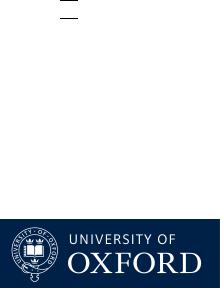
English
Established
Endowment
Chancellor
Vice-Chancellor Students Undergraduates Postgraduates Other students
Location
Colours
Athletics
Affiliations
Unknown, teaching existed since 1096 (age 915–916)
£3.3 billion (inc. colleges)
The Rt. Hon. Lord Patten of Barnes
Andrew Hamilton 21,000+ 11,723 9,327 461
Oxford, Oxfordshire, England, UK

 Oxford Blue
Oxford Blue
The Sporting Blue
IARU
Russell Group
Coimbra Group
Europaeum
EUA
G5
LERU
Website ox.ac.uk
TEXT. University of Oxford
The University of Oxford (informally Oxford University or Oxford) is a university located in Oxford, United Kingdom. It is the second-oldest surviving university in the world and the oldest in the English-speaking world. Although its exact date of foundation is unclear, there is evidence of teaching as far back as 1096. The University grew rapidly from 1167 when Henry II banned English students from attending the University of Paris.

In 1605 Oxford was still a walled city, but several colleges had been built outside the city walls.
(North is at the bottom on this map.)
In post-nominals, the University of Oxford was historically abbreviated as Oxon. (from the Latin Oxoniensis), although Oxford is now used in official university publications.
After disputes between students and Oxford townsfolk in 1209, some academics fled north-east to Cambridge, where they established what became the University of Cambridge. The two ancient English universities have many common features and are often jointly referred to as Oxbridge. In addition to their cultural and practical associations, as a historic part of British society, they have a long history of rivalry with each other.
Oxford was long considered a bastion of male privilege, and it was not until 7 October 1920 that women became eligible for admission as full members of the university and were given the right to take degrees.
The university is a federation: it comprises over forty self-governing colleges and halls, along with a central administration headed by the ViceChancellor.
Keble College, one of the constituent colleges of the University of Oxford
All resident students, and most academic staff, must be members both of a college or hall, and of the university. The heads of Oxford colleges are known by various titles, according to the college, including warden, provost, principal, president, rector, master and dean. The
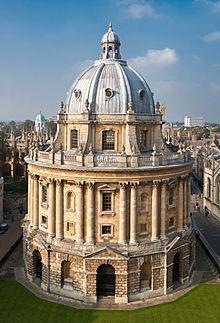
colleges join together as the Conference of Colleges to discuss policy and to deal with the central University administration. In addition to residential and dining facilities, the colleges provide social, cultural, and recreational activities for their members.
Oxford has 102 libraries, of which 30 belong to the Bodleian Library group, Oxford's central research library.
The Radcliffe Camera, built 1737–1749 as Oxford's science library, now holds books from the English, History, and Theology collections.
Oxford maintains a number of museums and galleries in addition to its libraries. The Ashmolean Museum, founded in 1683, is the oldest museum in the UK, and the oldest university museum in the world. It holds significant collections of art and archaeology, including works by Michelangelo, Leonardo da Vinci, Turner, and Picasso.
Academic dress is still commonly seen at Oxford; until the 1960s students wore it at all times. It is required for examinations and when visiting university officers. Other traditions and customs vary by college, one of the most common being the requirement to wear gowns for dinner in hall.
The University of Oxford is a "public university" in the sense that it receives a large amount of public money from the government and from local authorities, but it is a "private university" in the sense that it is entirely self-governing and could choose to become entirely private by rejecting public funds.
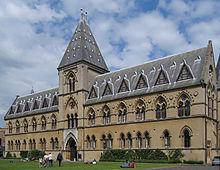
Oxford University Museum of Natural History.
Oxford regularly contends with Cambridge for first place in the league tables, and consistently ranks in the world's top 10 universities. For more than a century, it has served as the home of the Rhodes Scholarship, which brings students from a number of countries to study at Oxford as postgraduates or for a second bachelor's degree.
The list of distinguished scholars at the University of Oxford is long and includes many who have made major contributions to British politics, the sciences, medicine, and literature. More than forty Nobel laureates and more than fifty world leaders have been affiliated with the University of Oxford.
2. Link the words in the left column with their dictionary definitions in the right column. Memorize new words.
1. scholarship |
a) living at a school or institution |
2. private |
b) successful, authoritative, and |
|
commanding great respect |
3. resident |
c) a senior administrative officer in certain |
|
colleges and universities |
4. laureate |
d) a grant or payment made to support a |
|
student's education |
5. evidence |
e) belonging to or for the use of one |
|
particular person or group of people only |
6. distinguished |
f) the study of human history and |
|
prehistory through the excavation of |
|
sites and the analysis of artifacts and |
|
other physical remains |
7. privilege |
g) a person who is honored with an award |
|
for outstanding creative or intellectual |
|
achievement |
8. archaeology |
h) information indicating whether a belief |
|
or proposition is true or valid |
9. residential |
i) a special right, advantage, or immunity |
|
granted or available only to a particular |
|
person or group of people |
10. provost |
j) designed for people to live in |
|
|
3. Find the synonyms. Match a line in A with a line in B.
A |
B |
1. exact |
a) general |
2. ancient |
b) chief |
3. common |
c) important |
4. practical |
d) antique |
5. central |
e) main |
6. various |
f) several |
7. significant |
g) accurate |
8. major |
h) useful |
|
|
4.Find in the text English equivalents of the following Russian words or word-combinations.
Учреждать; общие черты; особенности; вдобавок, дополнительно; полноправный член; давать право; преподавательский состав; в соответствии с (чем-либо); иметь дело с (чем-либо); места отдыха и развлечений; научно-техническая библиотека; некоторое количество, несколько; университетская форма; традиции и обычая; требование; государственные деньги; местные власти; отказываться; соревноваться; степень бакалавра; выдающиеся ученые; делать значительный вклад; присоединяться.

5. |
Match a line in A with a line in B to make a sentence. |
|
A |
|
B |
1. |
The two ancient English |
a) a bastion of male privilege |
universities are … |
|
|
2. |
The University of Oxford is … |
b) academic dress at all times |
3. |
The colleges join together … |
c) often jointly referred to as |
|
|
Oxbridge |
4. |
Oxford and Cambridge have … |
d) located in Oxford, United |
|
|
Kingdom |
5.The list of distinguished scholars e) to discuss policy includes …
6.Oxford was long considered … f) a long history of rivalry with
|
|
each other |
7. |
Until the 1960s students wore … |
g) holds significant collections of |
|
|
art and archaeology |
8. |
Oxford regularly contends with |
h) many who have made major |
Cambridge for … |
contributions to British politics |
|
9. |
The Ashmolean Museum … |
i) first place in the league tables |
6. Correct the wrong statements using the text. Give your reasons in 2 or 3 sentences.
a)The list of distinguished scholars at the University of Oxford is long and includes many who have made major contributions to American politics, the sciences, medicine, and literature.
b)The Ashmolean Museum, founded in 1683, is the oldest museum in the UK.
c)For more than a century, Oxford has served as the home of the Rhodes Scholarship.
d)After disputes between students and Cambridge townsfolk in 1209,
some academics fled north-east to Oxford.
f)Women were eligible for admission as full members of the university and were given the right to take degrees since 1860.
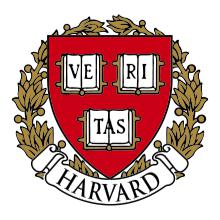
7. Answer the following questions:
a)Where is the University of Oxford located?
b)When was it founded?
c)How was Oxford historically abbreviated?
d)When were women given the right to take degrees?
e)How many colleges does Oxford comprise?
f)What titles are the heads of Oxford colleges known by?
g)Why do the colleges join together as the Conference of Colleges?
h)How many libraries does the Oxford University have?
i)When was the Ashmolean Museum founded? What collections does it hold?
j)What does Oxford contend with Cambridge for?
8.Give the title to each passage of the text to make the plan of it. Retell the text.
9.Pairwork. Make up a dialogue. Student A is a current student of Oxford, Student B wants to enter this university. Discuss the advantages of Oxford University.
HARVARD UNIVERSITY
1. Read the text. Guess the meaning of the words in bold.
Harvard University
|
Seal of Harvard University |
|
Motto |
Veritas |
|
Motto in |
Truth |
|
English |
||
|
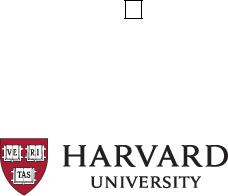
Established Type Endowment President Academic staff
Admin. staff
Students
Undergraduates
1636 Private
US$32 billion (2011) Drew Gilpin Faust 2,107
2,497 non-medical
10,674 medical
21,225
7,181 total
6,655 College
526 Extension
Postgraduates |
14,044 |
|
|
|
Location |
Cambridge, Massachusetts, U.S. |
|||
|
Urban |
|||
|
210 acres (85 ha) (Main campus) |
|||
Campus |
22 acres (8.9 ha) (Medical |
|||
campus) |
||||
|
||||
|
359 acres (145 ha) (Allston |
|||
|
campus) |
|||
Newspaper |
The Harvard Crimson |
|||
|
|
|||
Colors |
Crimson |
|
|
|
|
41 Varsity Teams |
|||
Athletics |
Ivy League |
|||
|
NCAA Division I |
|||
Nickname |
Harvard Crimson |
|||
Website |
Harvard.edu |
|||
TEXT. Harvard University
Harvard University is an American private Ivy League research university located in Cambridge, Massachusetts, United States, established in 1636 by the Massachusetts legislature. Harvard is the oldest institution of higher learning in the United States and the first corporation (officially
The President and Fellows of Harvard College) chartered in the country. Harvard's history, influence, and wealth have made it one of the most prestigious universities in the world.
Harvard was named after its first benefactor, John Harvard. Although it was never formally affiliated with a church, the college
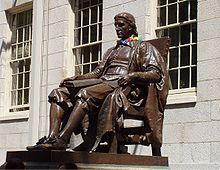
primarily trained Congregationalist and Unitarian clergy. Harvard's curriculum and students became increasingly secular throughout the 18th century and by the 19th century had emerged as the central cultural establishment among Boston elites.
The John Harvard statue in Harvard Yard is occasionally a target of humorous decorations,
such as the colorful lei shown above.
Following the American Civil War, President Charles W. Eliot's forty year tenure (1869–1909) transformed the college and affiliated professional schools into a centralized research university, and Harvard became a founding member of the Association of American Universities in 1900. James Bryant Conant led the university through the Great Depression and World War II and began to reform the curriculum and liberalize admissions after the war. The undergraduate college became coeducational after its 1977 merger with Radcliffe College. Drew Gilpin Faust was elected the 28th president in 2007 and is the first woman to lead the university. Harvard has the largest financial endowment of any academic institution in the world, standing at $32 billion as of September 2011.
The university comprises eleven separate academic units—ten faculties and the Radcliffe Institute for Advanced Study—with campuses throughout the Boston metropolitan area. Harvard's 210-acre (85 ha) main campus is centered on Harvard Yard in Cambridge, approximately 3.4 miles (5.5 km) northwest of downtown Boston. The business school and athletics facilities, including Harvard Stadium, are located across the Charles River in Allston and the medical, dental, and public health schools are located in the Longwood Medical Area.
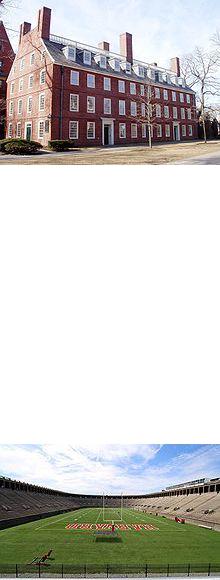
Massachusetts Hall (1720) is the oldest building in the Harvard campus
As of 2010, Harvard employs about 2,100 faculties to teach and advise approximately 6,700 undergraduates (Harvard College) and 14,500 graduate and professional students. Eight U.S. presidents have been graduates, and 75 Nobel Laureates have been student, faculty, or staff affiliates. Harvard is also the alma mater of sixty-two living billionaires, the most in the country. The Harvard University Library is the largest academic library in the United States, and one of the largest in the world.
The Harvard Crimson competes in 41 intercollegiate sports in the NCAA Division I Ivy League.
Harvard Stadium, home of Harvard Crimson and the Boston Cannons
Harvard has an intense athletic rivalry with Yale University traditionally culminating in The Game, although the Harvard–Yale Regatta predates the football game. This rivalry, though, is put aside every two years when the Harvard and Yale Track and Field teams come together to compete against a combined Oxford University and Cambridge University team, a competition that is the oldest continuous international amateur competition in the world.
2. Link the words in the left column with their dictionary definitions in the right column. Memorize new words.
1. curriculum |
a) the body of all people ordained for |
|
religious duties |
|
|
